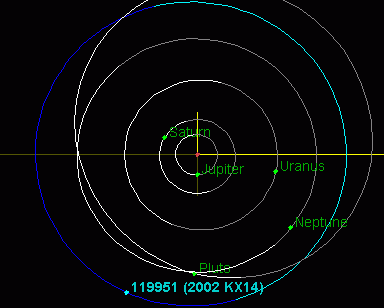 Hubble Space Telescope image of 2002 KX14 taken in 2006 | |
| Discovery[1] | |
|---|---|
| Discovered by | Michael E. Brown, Chad Trujillo |
| Discovery date | 17 May 2002 |
| Designations | |
| (119951) 2002 KX14 | |
| TNO cubewano[2] plutino-like | |
| Orbital characteristics[1][2] | |
| Epoch 13 January 2016 (JD 2457400.5) | |
| Uncertainty parameter 3 | |
| Observation arc | 10192 days (27.90 yr) |
| Earliest precovery date | 31 May 1984 |
| Aphelion | 40.491 AU (6.0574 Tm) |
| Perihelion | 37.244 AU (5.5716 Tm) |
| 38.867 AU (5.8144 Tm) | |
| Eccentricity | 0.041762 |
| 242.32 yr (88506.6 d) | |
Average orbital speed | 4.77 km/s |
| 261.303° | |
| 0° 0m 14.643s / day | |
| Inclination | 0.40348° |
| 286.686° | |
| ≈ 30 May 2085[3] ±13 days | |
| 71.686° | |
| Earth MOID | 36.2388 AU (5.42125 Tm) |
| Jupiter MOID | 32.2786 AU (4.82881 Tm) |
| Physical characteristics | |
| Dimensions | 496±9×230±27 km[4] |
| 393±19 km[5] 365+30 −21 km[6] 455±27 km[7] 415±1 km (chord)[6] | |
| 9–11 h[6] | |
| 0.097+0.014 −0.013[7] | |
| Temperature | ≈45 K |
| 20.4 (opposition)[8][9] | |
| 4.862±0.038,[7] 4.6[1] | |
(119951) 2002 KX14 (provisional designation 2002 KX14) is a medium-sized trans-Neptunian object (TNO) residing within the Kuiper belt. It was discovered on 17 May 2002 by Michael E. Brown and Chad Trujillo.[1]
It has a semi-major axis, orbital period and orbital eccentricity close to that of a plutino.[10] The orbital periods of plutinos cluster around 247.2 years (1.5 times Neptune's orbital period), close to 2002 KX14's orbital period. However, 2002 KX14 is not a plutino, as it is not actually in a resonance with Neptune, and it may have formed near its present nearly circular orbit lying almost perfectly on the ecliptic. This TNO may have remained dynamically cold since its formation, and thus its orbit may not have been a direct result of significant perturbations from Neptune during its migration to the outer solar system. The Deep Ecliptic Survey (DES) currently classifies it as a cubewano (classical) based on a 10-million-year integration of the orbit.[2]
2002 KX14 comes to opposition in late May at an apparent magnitude of 20.4.[8][9] This makes it about 360 times fainter than Pluto.[11]

- ^ a b c d "JPL Small-Body Database Browser: 119951 (2002 KX14)". (last obs). 26 April 2006. Retrieved 7 April 2016.
- ^ a b c Marc W. Buie (26 April 2006). "Orbit Fit and Astrometric record for 119951". SwRI (Space Science Department). Archived from the original on 20 May 2011.
- ^ JPL Horizons Observer Location: @sun (Perihelion occurs when deldot changes from negative to positive. Uncertainty in time of perihelion is 3-sigma.)
- ^ "(119951) 2002 KX14 2020 May 26". euraster.net. Euraster. 26 May 2020. Retrieved 19 September 2020.
- ^ Cite error: The named reference
Kretlow2021was invoked but never defined (see the help page). - ^ a b c Cite error: The named reference
occultationwas invoked but never defined (see the help page). - ^ a b c Cite error: The named reference
TNOsCool6was invoked but never defined (see the help page). - ^ a b "(119951) = 2002 KX14". minorplanetcenter.net. IAU Minor Planet Center. Retrieved 28 November 2022.
- ^ a b "HORIZONS Web-Interface". JPL Solar System Dynamics. Retrieved 20 July 2008.
- ^ John S. Lewis (2004). "Plutinos 2nd paragraph". Physics and Chemistry of the Solar System. Academic Press. p. 410. ISBN 978-0-12-446744-6.
- ^ (5th root of 100)^(20.4-14=363)
